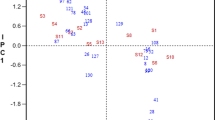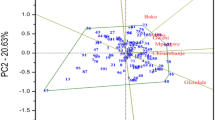Abstract
Maize is the major staple food in southern Africa with human consumption averaging 91 kg capita−1 year−1, and normal maize is nutritionally deficient in two essential amino acids: tryptophan and lysine. Despite the development of quality protein maize (QPM) with high tryptophan and lysine, stunting and kwashiorkor remain high in sub-Saharan Africa due to lack of high yielding and adapted QPM varieties. This study aimed at evaluating a new generation of QPM varieties for yield and related agronomic traits. Before the QPM varieties were validated on-farm, they were simultaneously selected on-station under five different management conditions. In the 2014/2015 season, 10 elite QPM varieties were selected from on-station trials based on high grain yield and stability, and were compared with the best commercial check varieties on-farm. During the 2015/2016 season, some poorly performing QPM varieties were dropped while new ones were added, resulting in 12 elite QPM varieties being evaluated on-farm. Analysis of variance for the 2014/2015 season showed non-significant hybrid × management condition interaction. Mean grain yields across management conditions ranged from 1.5 to 4 t ha−1 and were higher under mild stress (2.3–5.5 t ha−1) compared to random stress conditions (1.1–2.9 t ha−1). Broad sense heritability estimates were low to moderate (11–69%), and thus could still permit effective selection of better genotypes. Yield advantage ranged from 12 to 25% across the 2 years, suggesting effective genetic gains in QPM breeding. QPM hybrids CZH132044Q, CZH142238Q and CZH142236Q were stable and high yielding. Promotion of such QPM hybrids may help reduce protein energy malnutrition.


Similar content being viewed by others
References
Annicchiarico P, Pecetti L, Boggini G, Doust MA (2000) Repeatability of large-scale germplasm evaluation results in durum wheat. Crop Sci 40:1810–1814
Badu-Apraku B (2006) Estimates of genetic variances in Striga resistant extra-early- maturing maize populations. J. New Seeds 8(2):23–43
Badu-Apraku B (2007) Genetic variances and correlations in an early tropical white maize population after three cycles of recurrent selection for Striga resistance. Maydica 52(15):205–217
Bänziger M (2000) Breeding for drought and nitrogen stress tolerance in maize: from theory to practice. CIMMYT, Mexico
Bänziger M, Setimela PS, Hodson D, Vivek B (2004) September. Breeding for improved drought tolerance in maize adapted to southern Africa. In: New directions for a diverse planet: proceedings of the 4th international crop science congress, vol 26 Brisbane, Australia
Bänziger M, Setimela PS, Hodson D, Vivek B (2006) Breeding for improved abiotic stress tolerance in maize adapted to southern Africa. Agric Water Manag 80(1):212–224
Bernardo R (2002) Breeding for quantitative traits in plants. Stemma Press, Woodbury
Bressani R (1975) In high protein quality maize, dowden. Hutchinson and Ross, Stroudsberg, pp 38–57
Bressani R (1992) Nutritional value of high-lysine maize in humans. In: Mertz ET (ed) Quality protein maize. American Association of Cereal Chemistry, St Paul, pp 205–225
Byerlee D, Eicher CK (1997) Africa’s emerging maize revolution. Lynne Rienner Publishers, Boulder
Cromwell RE, Peterson GW (1983) Multicondition-multimethod family assessment in clinical contexts. Fam Process 22(2):147–163
FAO (1995) Malnutrition and micronutrient deficiencies. Agriculture food and nutrition for Africa—a resource book for teachers of agriculture. Food and Agriculture Organisation, Rome
Finlay KW, Wilkinson GN (1963) The analysis of adaptation in a plant breeding programme. Austin J Agric Res 14:742–754
Gasura E, Setimela PS, Souta CM (2015) Evaluation of the performance of sorghum genotypes using GGE biplot. Can J Plant Sci 95(6):1205–1214
GenStat. (2014) VSN International. GenStat for Windows 15th ed. VSN International, Hemel Hempstead, UK. GenStat.co.uk. Accessed 16 Jan 2016
Kniep KR, Mason SC (1991) Lysine and protein content of normal and opaque-2 maize grain as influenced by irrigation and nitrogen. Crop Sci 31(1):177–181
Krivanek AF, De Groote H, Gunaratna NS, Diallo A, Friesen D (2007) Breeding and disseminating quality protein maize (QPM) for Africa. Afr J Biotech 6:312–332
Lauderdale J (2000) Issues regarding targeting and adoption of Quality Protein Maize (QPM) CIMMYT, Mexico DF
Magorokosho C, Vivek B, MacRobert J (2009) Characterization of maize germplasm grown in eastern and SA: results of the 2008 regional trials coordinated by CIMMYT. CIMMYT, Harare
Magorokosho C, Vivek B, MacRobert J (2010) Characterization of maize germplasm grown in eastern and southern Africa: results of the 2009 regional trials coordinated by CIMMYT. CIMMYT, Harare
Magorokosho C, Tarekegne A, MacRobert J (2011) Characterization of maize germplasm grown in eastern and southern Africa: results of the 2010 regional trials coordinated by CIMMYT. CIMMYT, Harare
Mertz ET, Bates LS, Nelson OE (1964) Mutant genes that change protein composition and increase lysine content of maize endosperm. Science 145:279–280
Nurit E, Tiessen A, Pixley KV, Palacios-Rojas N (2009) Reliable and inexpensive colorimetric method for determining protein-bound tryptophan in maize kernels. J Agric Food Chem 57(16):7233–7238
Nuss ET, Tanumihardjo SA (2011) Quality protein maize for Africa: closing the protein inadequacy gap in vulnerable populations. An international review. Adv Nutr J 2(3):217–224
Pixley KV, Bjarnason MS (1993) Combining ability for yield and protein quality among modified endosperm opaque-2 tropical maize inbreds. Crop Sci 33(6):1229–1234
Pixley KV, Bjarnason MS (2002) Stability of grain yield, endosperm modification, and protein quality of hybrid and open-pollinated quality protein maize (QPM) cultivars. Crop Sci 42(6):1882–1890
Prasanna BM, Vasal SK, Kassahun B, Singh NN (2001) Quality protein maize. Curr Sci 81:1308–1319
Setimela P, Chitalu Z, Jonazi J, Mambo A, Hodson D, Bänziger M (2005) Environmental classification of maize-testing sites in the SADC region and its implication for collaborative maize breeding strategies in the subcontinent. Euphytica 145(1–2):123–132
Setimela PS, Magorokosho C, Lunduka R, Gasura E, Makumbi D, Tarekegne A, Cairns JE, Ndhlela T, Erenstein O, Mwangi W (2017) On-farm yield gains with stress-tolerant maize in eastern and southern Africa. Agron J 109(2):406–417
Vanlauwe B, Kihara J, Chivenge P, Pypers P, Coe R, Six J (2011) Agronomic use efficiency of N fertilizer in maize-based systems in SSA within the context of integrated soil fertility management. Plant Soil 339(1–2):35–50
Vasal SK (2001) High quality protein corn p. In: Hallauer AR (ed) Speciality corns. CRC Press, Boca Raton, pp 85–129
Vasal SK (2002) The role of high lysine cereals in animal and human nutrition in Asia, pp. 167 expert consultation and workshop, Bangkok, 29 April–3 May 2002. FAO, Bangkok
Vivek BS, Krivanek AF, Palacios-Rojas N, Twumasi-Afriyie SAO, Diallo AO (2008) Breeding quality protein maize (QPM): protocols for developing QPM cultivars. CIMMYT, Mexico
Yan W (2002) Singular-value partitioning in biplot analysis of multi-environment trial data. Agron J 94:990–996
Yan W, Tinker NA (2006) Biplot analysis of multi-environment trial data: principles and applications. Can J Plant Sci 86:623–645
Acknowledgements
This work was supported in part by the Drought Tolerance Maize for Africa (DTMA) project funded by the Bill and Melinda Gates Foundation, Africa Research in Sustainable Intensification for the Next Generation (Africa RISING) project funded by USAID and the MAIZE CGIAR research program. We thank the farmers and extension agents at each site for conducting the trials.
Author information
Authors and Affiliations
Corresponding author
Rights and permissions
About this article
Cite this article
Setimela, P.S., Gasura, E. & Tarekegne, A.T. Evaluation of grain yield and related agronomic traits of quality protein maize hybrids in Southern Africa. Euphytica 213, 289 (2017). https://doi.org/10.1007/s10681-017-2082-2
Received:
Accepted:
Published:
DOI: https://doi.org/10.1007/s10681-017-2082-2




